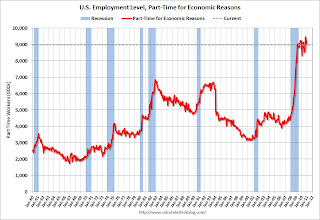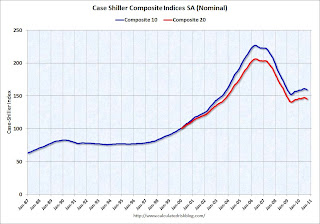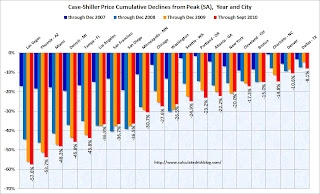by Calculated Risk on 12/05/2010 09:28:00 AM
Sunday, December 05, 2010
Summary for Week ending December 4th
Below is a summary of the previous week, mostly in graphs. Note: here is the economic schedule for the coming week.
• November Employment Report: 39,000 Jobs, 9.8% Unemployment Rate
The following graph shows the employment population ratio, the participation rate, and the unemployment rate.
 Click on graph for larger image in graph gallery.
Click on graph for larger image in graph gallery.
The unemployment rate increased to 9.8% (red line) from 9.6% in October.
The Employment-Population ratio declined to 58.2% in November matching the cycle low set in 2009 (black line).
The Labor Force Participation Rate was steady at 64.5% in November (blue line). This is the percentage of the working age population in the labor force. The participation rate is well below the 66% to 67% rate that was normal over the last 20 years.
 The second graph shows the job losses from the start of the employment recession, in percentage terms aligned at maximum job losses.
The second graph shows the job losses from the start of the employment recession, in percentage terms aligned at maximum job losses.
For the current employment recession, employment peaked in December 2007, and this recession is by far the worst recession since WWII in percentage terms, and 2nd worst in terms of the unemployment rate (only the early '80s recession with a peak of 10.8 percent was worse).
 The number of workers only able to find part time jobs (or have had their hours cut for economic reasons) declined slightly to 8.972 million in November. This has been around 9 million since August 2009 - a very high level.
The number of workers only able to find part time jobs (or have had their hours cut for economic reasons) declined slightly to 8.972 million in November. This has been around 9 million since August 2009 - a very high level.
These workers are included in the alternate measure of labor underutilization (U-6) that was steady at 17.0% in November. The high for U-6 was 17.4% in October 2009. Still very grim.
 This graph shows the number of workers unemployed for 27 weeks or more.
This graph shows the number of workers unemployed for 27 weeks or more.
According to the BLS, there are 6.313 million workers who have been unemployed for more than 26 weeks and still want a job. This was up from 6.206 million in October. It appears the number of long term unemployed has peaked, however the level is extremely high - and the increases over the last two months is very concerning.
Most of the underlying details of the employment report were weak. The positives included small upward revisions to the September and October payroll reports, a slight increase in average hourly earnings, and a slight decline in part time workers.
The negatives include the unemployment rate increasing to 9.8%, few payroll jobs added (only 39,000 jobs), the decline in the employment-population ratio, the steady participation rate at a very low level, and the increase in workers unemployed for over 26 weeks.
• Case-Shiller: Broad-based Declines in Home Prices in Q3
S&P/Case-Shiller released the monthly Home Price Indices for September (actually a 3 month average of July, August and September). This includes prices for 20 individual cities, and two composite indices (10 cities and 20 cities), and the quarterly national index.
 This graph shows the nominal seasonally adjusted Composite 10 and Composite 20 indices (the Composite 20 was started in January 2000).
This graph shows the nominal seasonally adjusted Composite 10 and Composite 20 indices (the Composite 20 was started in January 2000).
The Composite 10 index is off 29.8% from the peak, and down 0.7% in September(SA).
The Composite 20 index is off 29.6% from the peak, and down 0.8% in September (SA).
The next graph shows the price declines from the peak for each city included in S&P/Case-Shiller indices.
 Prices increased (SA) in only 1 of the 20 Case-Shiller cities in September seasonally adjusted. Only Wash, D.C. saw a price increase (SA) in September, and that was very small.
Prices increased (SA) in only 1 of the 20 Case-Shiller cities in September seasonally adjusted. Only Wash, D.C. saw a price increase (SA) in September, and that was very small.
Prices in Las Vegas are off 57.6% from the peak, and prices in Dallas only off 8.1% from the peak.
Prices are now falling - and falling just about everywhere. And it appears there are more price declines coming (based on inventory levels and anecdotal reports).
• U.S. Light Vehicle Sales 12.26 million SAAR in November
Based on an estimate from Autodata Corp, light vehicle sales were at a 12.26 million SAAR in November. That is up 13.2% from November 2009, and up slightly from the October 2010 sales rate.
 This graph shows the historical light vehicle sales (seasonally adjusted annual rate) from the BEA (blue) and an estimate for November (red, light vehicle sales of 12.26 million SAAR from Autodata Corp).
This graph shows the historical light vehicle sales (seasonally adjusted annual rate) from the BEA (blue) and an estimate for November (red, light vehicle sales of 12.26 million SAAR from Autodata Corp).
This is the highest sales rate since September 2008, excluding Cash-for-clunkers in August 2009.
This was above most forecasts of around 12.0 million SAAR.
• ISM Manufacturing Index decreases slightly to 56.6 in November
From the Institute for Supply Management: November 2010 Manufacturing ISM Report On Business® PMI was at 56.6% in November, down slightly from 56.9% in October. The consensus was for a decrease to 56.5%.
 Here is a long term graph of the ISM manufacturing index.
Here is a long term graph of the ISM manufacturing index.
In addition to the PMI, the ISM's new orders index was down to 56.6 from 58.9 in October.
The employment index decreased to 57.5 from 57.7 in October.
This was inline with the regional Fed manufacturing surveys.
• Other Economic Stories ...
• Restaurant Performance Index Rose to Three-Year High In October
• Hamilton: Europe and China: is this deja vu all over again?
• Michael Pettis: The rough politics of European adjustment.
• From Catherine Rampell at the NY Times: Persistence of Long-Term Unemployment Tests U.S.
• DOT: Vehicle miles driven increased in September
• From the Institute for Supply Management: October 2010 Non-Manufacturing ISM index showed expansion in November
• From the NAR:
Strong Rebound in Pending Home Sales
• ADP: Private Employment increased by 93,000 in November
• Unofficial Problem Bank list increases to 920 Institutions
Best wishes to all!
Saturday, December 04, 2010
Schedule for Week of December 5th
by Calculated Risk on 12/04/2010 08:45:00 PM
A light week for economic releases. The trade report on Friday is probably the key release ...
Note: Employment posts yesterday:
• November Employment Report: 39,000 Jobs, 9.8% Unemployment Rate
• Employment Summary and Part Time Workers, Unemployed over 26 Weeks
• Seasonal Retail Hiring: Retailers remain cautious
• Graphics Gallery for Employment
7:00 PM: Fed Chairman Bernanke discusses the economy on CBS 60 Minutes. This interview took place on November 30th.
1:15 PM Richmond Fed President Jeffrey Lacker speaks at Charlotte Chamber of Commerce's "Annual Economic Outlook Conference."
9:00 AM ET: Ceridian-UCLA Pulse of Commerce Index™ This is the diesel fuel index for November (a measure of transportation).
10:00 AM: Job Openings and Labor Turnover Survey for October from the BLS. This report has been showing a general increase in job openings, but very little turnover in the labor market.
3:00 PM: Consumer Credit for October. The consensus is for a $1 billion decline in consumer credit.
7:00 AM: The Mortgage Bankers Association (MBA) will release the mortgage purchase applications index. This index declined sharply following the expiration of the tax credit, and the index has only recovered slightly recently.
8:30 AM: The initial weekly unemployment claims report will be released. The number of initial claims has been trending down over the last several weeks. The consensus is for a decrease to 425,000 from 436,000 last week (still high, but lower than earlier this year).
10:00 AM: Monthly Wholesale Trade: Sales and Inventories for October. The consensus is 0.9% increase in inventories.
12:00 PM: Q3 Flow of Funds Accounts from the Federal Reserve.
8:30 AM: Trade Balance report for October from the Census Bureau. The consensus is for the U.S. trade deficit to be around $44 billion, the same level as in September.
9:55 AM: Reuters/University of Mich Consumer Sentiment preliminary for December. The consensus is for a slight increase to 72.5 from 71.6 in November.
After 4:00 PM: The FDIC might have a busy Friday afternoon ...
Participation Rate of 25 to 54 Age Men at Record Low
by Calculated Risk on 12/04/2010 04:34:00 PM
The collapse in the labor force participation rate has been one of the key stories of the great recession. The participation rate is the percentage of the working age population in the labor force.
The labor force participation rate has fallen from 66.2% in May 2008 to just 64.5% in November 2010.
A few weeks ago I looked at Labor Force Participation Rate: What will happen?. I looked at the aging of the population and concluded that the participation rate will probably increase to around 66% over the next 5 years before declining again - and that will keep upward pressure on the unemployment rate.
However one of the key trends has been the decline in the participation rate of men - and that is continuing.
 Click on graph for larger image.
Click on graph for larger image.
This graph shows the changes in the participation rates for men and women since 1960 (in the 25 to 54 age group - the prime working years).
The participation rate for men in this key demographic fell to a record low 88.8% in November.
An important question is: how much of the recent decline in this key participation rate is cyclical because of the recession, and how much is part of the long term trend. We won't know for sure until the labor market starts to recover.
Employment Graph Repeat
by Calculated Risk on 12/04/2010 11:50:00 AM
A repeat of a key graph ...
 Click on graph for larger image.
Click on graph for larger image.
This graph shows the job losses from the start of the employment recession, in percentage terms.
The dotted line shows payroll employment excluding temporary Census workers.
This is by far the worst post WWII employment recession.
 This second graph shows the same information aligned at maximum job losses.
This second graph shows the same information aligned at maximum job losses.
Not only is this the deepest post WWII recession in terms of payroll job losses, but the recovery is very sluggish. I'll have more on employment later today ...
Employment posts yesterday:
• November Employment Report: 39,000 Jobs, 9.8% Unemployment Rate
• Employment Summary and Part Time Workers, Unemployed over 26 Weeks
• Seasonal Retail Hiring: Retailers remain cautious
• Graphics Gallery for Employment
Unofficial Problem Bank list increases to 920 Institutions
by Calculated Risk on 12/04/2010 08:33:00 AM
Note: this is an unofficial list of Problem Banks compiled only from public sources.
Here is the unofficial problem bank list for Dec 3, 2010.
Changes and comments from surferdude808:
It was a very quiet week for the Unofficial Problem Bank List. There were two additions and one removal because of duplication.
The two additions were First Community Bank, Glasgow, MT ($219 million) and Monadnock Community Bank, Peterborough, NH ($110 million), which is the first institution from New Hampshire to appear on the Unofficial Problem Bank List. The duplicated entry was SouthBank, a Federal Savings Bank, Cornith, MS, which has relocated to Huntsville, AL.
The other change is the termination of a Prompt Corrective Action order by the OTS issued against Aurora Bank FSB, Wilmington, DE ($4.4 billion). After these changes, the Unofficial Problem Bank List includes 920 institutions with assets of $410.3 billion.
Friday, December 03, 2010
Survey: Small Business job creation improves slightly in November
by Calculated Risk on 12/03/2010 08:18:00 PM
From National Federation of Independent Business (NFIB) chief economist William Dunkelberg: Small Business Job Creation Positive in November
“In November, small business owners reported net new job creation. It wasn’t much, an average per firm increase of .01 workers, up from 0.0 in October. Seasonally adjusted, 14 percent of owners reported increasing employment at their firms by an average of 3.4 workers, the highest reading since December 2007 (the peak of the last expansion according to the National Bureau of Economic Research). On the down side, 16 percent reported reducing employment, an average of 3.2 workers. Bottom line, job creation was positive in November.Not much, but a step in the right direction.
...
[P]lans to create jobs gained three points, rising to a net 4 percent of all owners, the best reading in almost two years (this after a four point improvement in job creation plans in October, a solid trend that promises a pickup in the pace of job creation).
Earlier employment posts:
• November Employment Report: 39,000 Jobs, 9.8% Unemployment Rate
• Employment Summary and Part Time Workers, Unemployed over 26 Weeks
• Seasonal Retail Hiring: Retailers remain cautious
• Graphics Gallery for Employment


